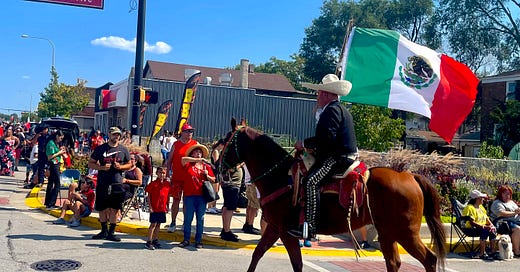On September 15, I witnessed history. East Chicago, Indiana, where I live and grew up, celebrated the 100th anniversary of its first Mexican Independence Day parade. People from throughout the area gathered on our streets. The music blared, and the people shouted, “¡Viva México!” There have only been two years in its history when the parade was interrupted, in 2001 and 2020. These facts still astound me.
A few days after the parade, a friend and I were texting and remembering how important it has always been. She moved to California some time ago but was nostalgic about being here. It’s still home for her in many ways. In our conversation, we both agreed that the first people to organize those parades were brave because they certainly faced resistance and racism.
In time, local politicians seeking votes, businesses, and military veterans in their uniforms would walk among the green, white, and red. Charros still twirl their lassos atop their horses and toss candies to the onlookers while crying out, ¡Viva México! I had to be there, but it made me ask, “Why do I celebrate Mexican Independence in another country?”

Part of the answer is simple for me. I am a citizen of two countries. I travel with two passports, and what happens in Mexico has always concerned me. I have grown to understand Mexico’s rich, beautiful, often painful history. I also know of the long, complex, usually unequal relationship between the United States and Mexico. I’m also not blind to Mexico’s hand in its own troubles, so I try to maintain a sober view of official stories wherever they come from.
Questioning the official narrative might push me away from celebrating most anything. After all, significant historical events often become myths full of heroes who achieve superhuman status. They can seem like untouchable gods in an imaginary world. So, what has connected me to Mexico and shaped my heart? Why do I celebrate Mexican Independence? When I walked away from the parade, I remembered. It’s regular, mostly unknown people. That’s what I believe we celebrate in East Chicago, Indiana.
We came to work in the steel mills and built shops, bakeries, restaurants, movie theaters, dance halls, and mutual aid organizations. We created families. Lived and died here and in service to this country. We survived mass deportations during the 1930s, 1950s, 1970s and 1980s. We brought our faith, too. Our Lady of Guadalupe, my parish community, is 98 years old. We celebrate the thousands who would make their way here and go back and forth, those who kept us grounded when industry declined. We gave our best to the United States.
We celebrate that and Mexicanidad, our ancient roots, thousands of years old. However faint, something remains: a story, a word, a recipe, a dish, an old piece of art, a memory of someone, what they did, or the town they came from or returned to. For me, and I believe for most of us, these celebrations are about honoring those people and what they’ve given us.
I think this is what most people celebrate when they wave a Mexican flag or proudly claim Mexican ancestry. Many have never been to Mexico, but fragments of Mexico remain in their lives. Some don’t speak Spanish or barely speak it, but they hear about aunts, uncles, parents, grandparents, ourselves, our struggles, and the grit and enduring beauty of our experiences. You won’t find these stories in history books, but we should write them on paper and in our hearts during September and all year long.




